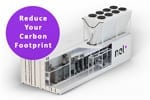 |
|
2/4/2021 |
Advanced sensors are crucial to any predictive maintenance strategy, and often these sensors must be quickly installed into difficult-to-reach spaces. A novel nanomaterial technology enables predictive sensors that can be “printed” onto flexible stickers. These stickers can be easily attached to rotating or static equipment, including pumps, valves and pipelines. »
 |
|
Today, synthetic routes to about 10% of the top 50 active pharmaceutical ingredients (APIs) include one or more Grignard reactions, which are used to form C–C bonds. Normally, the reaction is performed batch-wise in continuous stirred-tank reactors (CSTRs), with Grignard reagent added in limited amounts to restrict the generation of heat. This practice leads to long reaction times and increased formation of byproducts. Now, researchers have eliminated these problems. »
Metal-oxide nanocrystals have applications in lubrication and electronics displays
Pixelligent Technologies Inc. (Baltimore, Md.; www.pixelligent.com) has developed a process for making metal-oxide nanocrystaline materials that have found uses as additives in a variety of industrial lubricants, mixed- and augmented-reality (AR/MR) glasses, and various display technologies. »
|
Magnetic field cures adhesives faster with less energy
A major project targets sustainable urea production
Conventional adhesives, such as epoxy, are designed to cure using moisture, heat and light. Curing is necessary to cross-link and bond the glue with the two secured surfaces as the glue crystallizes and hardens. Now, scientists from Nanyang Technological University (Singapore; www.ntu.edu.sg) have developed a new adhesive that can be cured using a magnetic field. »
A consortium, led by the Netherlands Organization for Applied Scientific Research (TNO; The Hague; www.tno.nl), has received an exceptional grant of €21 million from the European Commission under the Horizon 2020 Framework Program to investigate and develop the potential of industrial symbiosis to convert residual gas emissions from steel production into resources for urea production. »
Researchers from the National University of Singapore (www.nus.edu.sg), led by associate professor He Jianzhong, have found a new strain of bacterium called Thauera sp. strain SND5, which is capable of simultaneous nitrification and denitrification and phosphate removal from wastewater. The discovery has the potential to significantly reduce the operational costs and emission of greenhouse gases associated with traditional wastewater treatment methods. »
| More News |
|
|
 |
| Bookstore | Jobs | Plant Cost Index | Subscribe |
© 2021 Access Intelligence, LLC. All rights reserved.

